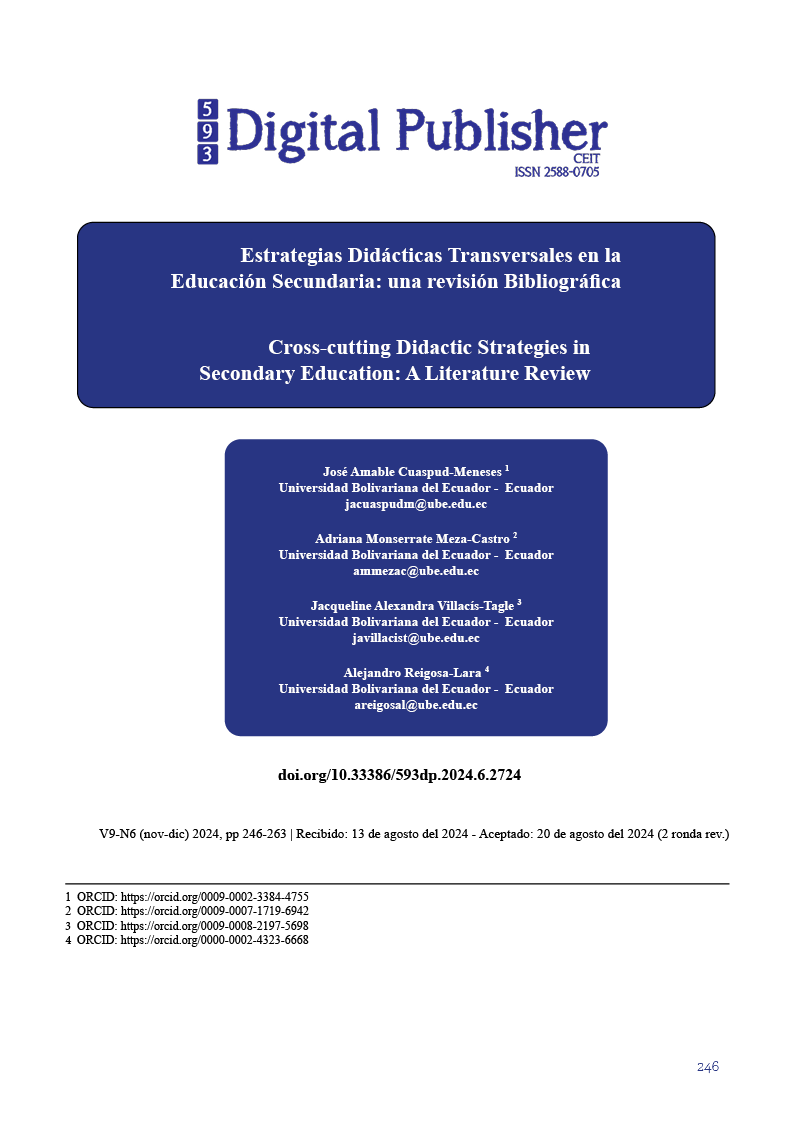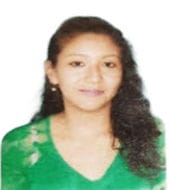Cross-cutting Didactic Strategies in Secondary Education: A Literature Review
Main Article Content
Abstract
The research work covers the importance of transversal teaching strategies in secondary education in increasing student learning, aiming to provide bibliographic information about the teaching strategies used in the classroom, detecting the main strengths for the learning process. Teaching-learning at the secondary education level as it faces continuous challenges.
The importance of transversal teaching strategies lies in generating learning for students through procedures and skills that, when acquired, can be used in various situations that arise and facilitate teachers' teaching in a comprehensive and efficient manner.
The methodology applied was PRISMA, where a bibliographic search of academic literature and official documents related to transversal teaching strategies in secondary education was carried out. Sources include articles from academic journals, reports from educational organizations, and case studies from various regions.
As conclusions from the work developed, we have that the implementation of teaching strategies in the classroom are of utmost importance according to different authors since this avoids falling into routine and keeps students motivated, benefiting their learning.
Downloads
Article Details

This work is licensed under a Creative Commons Attribution-NonCommercial-ShareAlike 4.0 International License.
1. Derechos de autor
Las obras que se publican en 593 Digital Publisher CEIT están sujetas a los siguientes términos:
1.1. 593 Digital Publisher CEIT, conserva los derechos patrimoniales (copyright) de las obras publicadas, favorece y permite la reutilización de las mismas bajo la licencia Licencia Creative Commons 4.0 de Reconocimiento-NoComercial-CompartirIgual 4.0, por lo cual se pueden copiar, usar, difundir, transmitir y exponer públicamente, siempre que:
1.1.a. Se cite la autoría y fuente original de su publicación (revista, editorial, URL).
1.1.b. No se usen para fines comerciales u onerosos.
1.1.c. Se mencione la existencia y especificaciones de esta licencia de uso.
References
Aguilar-Gordón, F. (2019). Fundamento, evolución, nodos críticos y desafíos de la educación ecuatoriana actual. Revista Electrónica “Actualidades Investigativas en Educación”, 19(1), pp1-31. DOI: 10.15517/aie. v19i1.35715.
AVILA-FAJARDO, Gloria Patricia and RIASCOS-ERAZO, Sandra Cristina. Propuesta para la medición del impacto de las TIC en la enseñanza universitaria. educ.2011, vol. 14, n. 1, pp. 169-188. ISSN 0123-1294.
Beltrán Llera, J. (1998). Procesos, Estrategias y Técnicas de Aprendizaje. Madrid: Síntesis.
Benavides, C.; Mahecha, J. y Conejo, F. (2021). Estrategias didácticas que inciden en la motivación de los estudiantes inscritos en el curso de Práctica en Responsabilidad Social de la sede de uniminutovirtual y a Distancia. Estrategias didácticas que afectan a motivada dos alumnos matriculados no curso Pirático de Responsabilidad Social da sede da Un minuto Virtual y a Distancia. Brasilina Journal of Development, Curitiba, v.7, n.3, p. 30880-30898. DOI: 10.
Biolchini, J., Mian, P.G., Natali, A.C. and Travassos, G.H. (2005) “Systematic Review in Software Engineering: Relevance and Utility”, Technical Report ES67905, PESC - COPPE/UFRJ. Available at http://cronos.cos.ufrj.br/publicacoes/reltec/es67905.pdf.
Cabero, J.; Arancibia, M.; Del Pete, A. (2019). Technical and Didactic Knowledge of the Moodle LMS in Higher Education. Beyond Functional Use. Journal of New Approaches in Educational Research, [S.l.], v. 8, n. 1, p. 25-33, jan. 2019. ISSN 2254-7339. Available at:<https://naerjournal.ua.es/article/view/327>.Doi:http://dx.doi.org/10.7821/naer.2019.1.327.
Cárdenas, I., & Villanueva, S. (2019). Rendimiento académico: universo muy complejo para el que hacer pedagógico. Artículo científico Revista muro de investigación, Vol. 5(N 2). Obtenido de https://revistas.upeu.edu.pe/index.php/r-Muro investigaion/article/view/1325/1662.
Castillo, M. y Gamboa, R. (2017, 21 de julio). Desafíos de la educación en la sociedad actual. Revista Electrónica Diálogos Educativos, 12(24), 55-69. https://dialnet.unirioja.es/descarga/articulo/4156179.pdf.
Cedeño, A., & Ochoa, M. (2019). Las estrategias didácticas y su influencia en el aprendizaje significativo... (Tesis de Grado). Guayaquil: ULVR.
Day RA. (2005). Cómo escribir y publicar trabajos científicos (Tercera edición). Washington DC.Organización Panamericana de Salud.
Díaz, F. y Hernández, G. (2004). Estrategias docentes para un aprendizaje significativo: una interpretación constructivista. Ciudad de México, México: McGraw-Hill Interamericana.
Flores, J., Ávila, J., Rojas, C., Sáez, F., Acosta, R. y Díaz, C. (2017). Estrategias didácticas para el aprendizaje significativo en contextos universitarios. Concepción, Chile: Trama Impresores S.A.
Floréz, N. (20 de Diciembre de 2019). La motivación, el juego y el trabajo colaborativo como propuesta a optimizar el proceso enseñanza-aprendizaje en el Preescolar del Grado Jardín en el Colegio Agustiniano Norte de Bogotá. Bogotá, Colombia: Fundación Universitaria Los Libertadores. Obtenido de Core.ac: https://core.ac.uk/download/pdf/288315133.pdf.
Fullan, M., & Donnelly, K. (2016). Evaluating the Impact of Technology. Pearson.
García-Cabrero, B., Loredo, J. y Carranza, G. (2008). Análisis de la práctica educativa de los docentes: pensamiento, interacción y reflexión. Revista Electrónica de Investigación Educativa, Especial. En línea. Disponible en: http://redie.uabc.mx/NumEsp1/contenido-garcialoredocarranza.html.
Gibbons, M. (2002). The self-directed learning handbook: Challenging adolescent student to excel. San Francisco: John Wiley & Sons Inc.
González, S. y Triviño, A. (2018). Las estrategias didácticas en la práctica docente universitaria. - Teaching strategies in university teaching practice. Revista de curriculum y formación del profesor VOL.22, Nº2 (abril- junio, 2018). DOI: 10.30827/profesorado. v22i2.7728.
Hanushek, E. A. y Woessman, L. (2008). “The role of cognitive skills in economic development.” Journal of Economic Literature, vol. 46(3), pp. 607–68.
Hernández, M.; Diéguez, R.; Riol, M. (2020). Didactic strategy for teaching-learning of primary ophthalmological care for diabetics. Mediciego. 2020; 26(1):1-16. https://www.medigraphic.com/cgi-bin/new/resumenI.cgi?IDARTICULO=98822.
Horn, M., y Staker, H. (2011). The Rise of K-12 Blended Learning. Innosight Institute.
KAPP, Karl. Games, Gamification, and the quest for learner engagement. Training and Development, Reino Unido, v. 66, n. 6, p. 64-68, 2012.
Kitchenham, B. (2004). Procedures for performing systematic reviews. Keele University (Vol. 33). https://bit.ly/36170F5.
Kitchenham, B., y Charters, S. (2007). Guidelines for performing systematic literature reviews in soware engineering.
Larmer, J. y Mergendoller, J.R. (2010). 8 Essentials for Project-Based Learning. Educational Leadership, 68(1), 52-55. Recuperado de http://pvhigh.com/wpcontent/uploads/acad_senior_project_8_Essentials_EdLdr_2012_version.pdf.
Mard, N. y Hilli, C. (2020). Towards a didactic model for multidisciplinary, teaching - a didactic analysis of multidisciplinary, cases in Finnish primary schools. Journal of Curriculum Studies, DOI: 10.1080/00220272.2020.1827044.
Mariscal, A.y López, V. (2017). Retención de los conocimientos sobre el universo: Estudio en alumnos españoles de 5º de educación primaria, a partir de una estrategia didáctica basada en la terminología científica. RMIE, 2017, VOL. 22, NÚM. 72, PP. 235-271 (ISSN: 14056666).
Martínez, E. y Zea, E. (2004). Estrategias de enseñanza basadas en un enfoque constructivista. Revista Ciencias de la Educación, 2(24), 69-90.
Méndez, A., & Gutiérrez, D. (2016). Estrategias de enseñanza y aprendizaje. Una mirada desde diferentes niveles educativos. Mexico: Red Durango de Investigadores Educativos A. C.
Ministerio de educación. (2016). aplicación de la evaluación estudiantil. Obtenido de https://educacion.gob.ec/wp-content/uploads/downloads/2016/07/Instructivo-para-la-aplicacion-de-la-evaluacion-estudiantil.pdf.
Moorhouse, B. L., & Wong, K. M. (2021). Blended Learning during Post-Pandemic Times: A Teacher’s Reflections on its Implementation in an English for Academic Purposes Course. Research and Practice in Technology Enhanced Learning, 16(1), 1-16. Disponible en: DOI: 10.1186/s41039-021-00162-.
Navarrete, j., & Samuel, Z. (2020). Análisis de las estrategias didácticas para el diseño, selección, producción, utilización y validación de recursos educativos audiovisuales interactivos en una institución educativa. Estudio inicial. Artículo científico Revista.
Núñez, L.; Gallardo, D.; Aliaga, A. y Díaz, J. (2020). Didactic strategies in the development of critical thinking in secondary school students. Rev. Eleuthera [online]. 2020, vol.22, n.2, pp.31-50. Epub May 20, 2021. ISSN 2011-4532. https://doi.org/10.17151/eleu.2020.22.2.3.
Ordoñez Ocampo, B. P., Ochoa Romero, M. E., Erráez Alvarado, J. L., León González, J. L., & Espinoza Freire, E. E. (2021). Consideraciones sobre aula invertida y gamificación en el área de ciencias sociales. Revista Universidad y Sociedad, 13(3), 497-504.
Orduz, R. (2019). La educación en un contexto global. Dialéctica. Revista de Investigación Educativa, núm. 1. http://portal.amelica.org/ameli/jatsRepo/88/88741017/html/index.html.
Orellana, C. (2017). La estrategia didáctica y su uso dentro del proceso de enseñanza y aprendizaje en el contexto de las bibliotecas escolares. Revista Academica Vol.7. DOI 10.15517/ECI.V7I1.27241.
Orozco, J. (2016). Estrategias Didácticas y aprendizaje de las Ciencias Sociales. Revista Científica De FAREM-Estelí, (17), 65–80. https://doi.org/10.5377/farem.v0i17.2615.
Oseda, D.; Mendivel, R. y Angoma, M. (2020). Estrategias didácticas para el desarrollo de competencias y pensamiento complejo en estudiantes universitarios. Didactic strategies for the development of competences and complex thinking in university students. Sophia, Colección de Filosofía de la Educación, núm. 29, pp. 235-259, 2020. https://www.redalyc.org/journal/4418/441863461009/html/.
Pincay, M. (2022). Estrategias innovadoras para mejorar el desempeño docente en la educación general básica, distrito 6 Guayaquil 2021. Tesis de pregrado Universidad César Vallejo. Obtenido de https://repositorio.ucv.edu.pe/handle/20.500.12692/94190.
Posso, R., Barba L. y Otáñez, N. (2020). El conductismo en la formación de los estudiantes universitarios. Revista Educare Segunda Nueva Etapa 2.0. 24(1), 117-133. https://doi.org/10.46498/reduipb.v24i1.122.
Quesada, A. y Hernández, V. (2017). La transición por los niveles de comprensión de textos: Estrategia didáctica en la Educación Superior. Revista Dilemas Contemporáneos: Educación, Política y Valores. ISSN: 2007 – 7890. http://www.dilemascontemporaneoseducacionpoliticayvalores.com/
Quijije, M.; Muñoz, D.; Cuarán, G. y Cabezas, E. (2021). Diseño de Estrategias Didácticas para la Formación de Valores en los estudiantes de décimo año de Educación General Básica. Design of Didactic Strategies for the Formation of Values in tenth year students of Basic General Education. Pol. Con. Vol. 6, No 11, Noviembre 2021, pp. 1610-1625, ISSN: 2550 - 682X. http://polodelconocimiento.com/ojs/index.php/es.
Ramos, R. y Ramos, P. (2021). Gamificación: estrategia didáctica para el desarrollo de competencias en matemática. Revista de Investigación Científica y Tecnológica Alpha Centauri Volumen 2, Número 3, Julio-Setiembre 2021. https://doi.org/10.47422/ac.v2i3.51.
Reyes, O.; Andrade, M.; Ávila, F. y Moreira, L. (2020). Didactic strategies and the learning styles in an English class as a second language (esl class). International Journal of Psychosocial Rehabilitation Pages 14683-14697. DOI: 10.37200/IJPR/V24I8/PR281446.
Rodriguez, Y.; Obaya, A.; Vargas, Y. (2021). ICT: Didactic Strategy using Online Simulators for the Teaching Learning of the Law of Conservation of Matter and its Relationship to Chemical Reactions in Higher Middle Education. International Journal of Educational Technology and Learning ISSN: 2523-0581, Vol. 10, No. 2, pp. 56-67, 2021. DOI: 10.20448/2003.102.56.67.
Sandoval Soto, M. (2018). Modelo pedagógico aplicado en niños y niñas de básica media de la unidad educativa Velasco Ibarra. [Tesis de grado, Universidad Politécnica Salesiana cede Quito]. https://dspace.ups.edu.ec/bitstream/123456789/14967/1/UPS-QT12289.pdf.
Schwartz, T. A., Ajazi, E. y Monaco, J. (2018). Findings from a survey of statistics and biost.
Sung, Y.-T., Chang, K.-E., & Liu, T.-C. (2016). The effects of integrating mobile devices with teaching and learning on students' learning performance: A meta-analysis and research synthesis. Computers & Education, 94, 252-275. https://doi.org/10.1016/j.compedu.2015.11.008.
Tejedor, y.; barrón, a.; Fernández, m.; fuertes, m.; Ruiz, y.; Gutiérrez, j.; García, e.; Aramburuzabala, p. y Hernández, a. (2019). Didactic strategies to Promote Competencies in Sustainability. Revista Sustainability 2019, 11, 2086. Doi: 10.3390.
Tobón, J.; Marín, O.; Tapia, R. y Martín, M. (2021). Estrategia didáctica de aprendizaje basada en inteligencias múltiples predominantes y procesos autor regulatorios en estudiantes rurales de primaria. INNOVA Research Journal, 6(3), 34-57. https://doi.org/10.33890/innova.v6.n3.2021.1751.
UNESCO 2020). ¿Qué se espera que aprendan los estudiantes de América Latina y el Caribe? https://unesdoc.unesco.org/ark:/48223/pf0000373982/PDF/373982spa.pdf.multi.
Valdivia, P. (11 de Agosto de 2016). Estrategias didácticas para la enseñanza del idioma inglés a niños de preescolar: el caso de un colegio en Colima, México. Colima, México: Instituto Tecnológico y de Estudios Superiores de Occidente. Obtenido de Repositorio institucional DEL ITESO: https://rei.iteso.mx/handle/11117/3790.
Zamudio, G. (2019). Estrategias didácticas, inclusión y educación expandida. Didactic strategies, inclusión and expanded education. Revista boletín REDIPE: 8 (9) SEPTIEMBRE 2019 ISSN 2256-1536. https://dialnet.unirioja.es/descarga/articulo/7528309.pdf.





